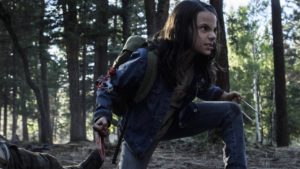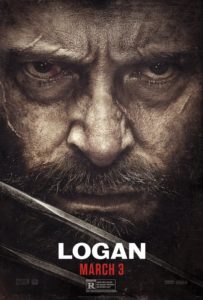Logan
Reviewed by Gavin Burrows 21-Mar-17
What happens when superheroes grow old? Logan addresses that question.
What happens when superheroes grow old? For the longest time, there seemed no need to ask the question. It wasn’t just that they were wish-fulfilment characters, or aimed at young audiences. Even within their own narratives, they were icons. If Superman stood for truth, justice and the American way, it made no more sense to ask why he wasn’t going grey than it did the American flag. Or for that matter the Coca-Cola logo. And of course the very reasons why ageing superheroes weren’t a thing were to become what made them a thing. Both Watchmen and Dark Knight, the two breakthrough adult superhero graphic novels, featured them.
Logan takes this up, with a title which comes from the X-Men’s Wolverine no longer answering to his own name. He’s now just Logan, a beat-up old guy. In the de rigeur opening scene, where the hero dispatches some petty hoods to re-demonstrate his powers, he wins only with difficulty. His chief antagonist is his younger, stronger, more aggressive self – the clone X-24.
And the movie underlines this aging in two ways. Firstly it sets itself in the future. X-Men: Days of Future Past had future scenes. But the focus of the film was on the past, and what future scenes they were featured the recognisably apocalyptic movie future – which has become almost comforting in its familiarity. Logan, in contrast, is set in the future which is fast becoming the more credible version. Where the only difference between it and the present is that things will have had more time to run down.
So the beat-up old guy inhabits a beat-up old world. He hides out with Professor X in a run-down smelting plant. An important plot info dump, delivered by mobile phone video, is delayed when the batteries go dead.
Secondly, Logan filches the central conceit from Children of Men, except with a Marvel twist – instead of no new children being born, there’s no new mutants coming out. And this notion has a bite to it. Comic fans are wont to wax over how liberal the concept of mutant phobia is, how it’s a metaphor for civil rights and a guide to embracing difference. But those are at best bolt-ons. At root it’s about the brainy, geeky kids taking to a narrative that asserts their innate superiority. It’s our difference which should be respected, because of course it’s so much more special than your difference. So, in a film aimed at comic fans, a world without mutants is almost automatically a world without hope.
 In a surprise plot twist known to anyone who’s seen the trailer, Laura then emerges as Logan’s claw-dragging daughter. Her journey from mute feral monster to socialised young adult sounds schematic and predictable in print, but works better in the telling. This is partly down to her portrayal. Rather than a cutesy movie kid who suddenly bares her claws in some shock twist, she’s is played from the outset as an outsider – uncommunicative, devoid of table manners. She’s like that freaky child you sometimes meet, who you feel obliged to try child-chatting with while they witchily stare you down.
In a surprise plot twist known to anyone who’s seen the trailer, Laura then emerges as Logan’s claw-dragging daughter. Her journey from mute feral monster to socialised young adult sounds schematic and predictable in print, but works better in the telling. This is partly down to her portrayal. Rather than a cutesy movie kid who suddenly bares her claws in some shock twist, she’s is played from the outset as an outsider – uncommunicative, devoid of table manners. She’s like that freaky child you sometimes meet, who you feel obliged to try child-chatting with while they witchily stare you down.
At the outset, Logan and Caliban are like a parodic form of an old married couple, institutionalised in their bickering. Caliban nags – and he uses the word “nags” – about Logan’s poor providing skills, while he’s stuck at home all day looking after the doolally father-in-law. But Laura’s arrival almost immediately pushes him off-stage. After which it’s the Professor who takes on the nurturing “motherly” role, while her actual father confines himself to commanding and upbraiding her, firmly telling her it’s “not okay” to skewer a shop assistant asking her to pay for her lunch. These roles are effectively replicated in the two villains, the threatening Pierce and the cajoling Rice.
And of course a switch is pulled, the same switch as will inevitably occur in any parent-child relationship. Logan’s function becomes to set Laura up for a life without him, a plan which must be accelerated due to his own impending mortality. (A notable feature of Logan is how many non-superhero films it’s been compared to. Perhaps Beasts of the Southern Wild should be added to the list.)
Throughout the film, the only times you see brightly-coloured spandex costumes are in the pages of comic books or on action figures. And the placing of X-Men comics diegitically within the narrative is significant. Robbie Collins of The Telegraph infers from this that “those earlier films were just films – and this paranoid, punishingly violent noir western is the real, shotgun-toting, limb-lopping deal.” Perhaps he’s right. But there’s a more direct purpose. Logan’s dismissal of them as romanticised fiction leads directly into his disbelief in Eden, the place where Laura and her fellow new mutants can escape to. As things turn out, it’s their believing in it which allows them to create it. He’s carried aloft there on a stretcher, as if heading into heaven.
He never makes it, of course. In fact the film suggests that human society is simply so screwed the next generation need to take off somewhere else and start from scratch. It’s as if it’s only capable of showing us our own future, but there is a potential better option which can only happen beyond our reach. The importance of our role is to tell them not to take after us. In the speech from Shane, quoted by Laura over Logan’s grave, it’s we who are the guns in the valley.
The film has a elliptical style, with just hints and passing references as to how things got to this. This mostly works in its favour but sometimes manifests as lapses. The way the captured Caliban is so quickly forgotten by the others seems dissatisfying. And Laura’s relationship to the other mutant children seems somewhat under-developed. We’re told they refused their allotted role of soldiers, and even when pursued they only seem to realise late in the day their special powers might come in handy. Laura, on the other hand, is the very definition of a born scrapper. Perhaps they are supposed to meet in the middle somewhere, but it isn’t really explained.
Goings-on are – be warned – bloody, gaining a 15 certificate in the UK and an R in America. The brutalism could be seen as a mark of realism, where we don’t watch superhero ballets but real fights which result in real injuries, and, more often than not, real death. But it’s one element of the film I remain agnostic about. Perhaps ultra-violence has just become too associated with all that Zack Snyder grimdark shit.
But, whatever the successes of the film, there’s a bigger caveat. The X-franchise is one of the few places in superherodom where women heroes can hang out, and it does seem something of a change to see them so excluded here. Expect no Storm, nor Mystique. Perhaps that was done to emphasise the barren-ness of the world, or to throw more emphasis onto Laura. And seeing male characters such as Caliban and the Professor take on “female” roles emphasises their arbitrary nature. But director James Mangold has spoken openly about the “ageing hero” films which influenced him (Unforgiven, The Cowboys, The Wrestler, etc.), which are male-oriented to a… well, to a man. Ageing in popular culture seems a manpainy event, even though, from what I hear, it happens to women too.
 As mentioned in my review of X-Men Apocalypse, the decade-leaping structure of the X-films is smart, as it keeps pushing them into somewhere new. And if Logan is the longest leap so far, it also lands in the most interesting place. It’s often tempting to regard mature superhero films as something like gobstoppers for gourmets, a virtual category error. But it seems that sometimes they can work. The tenth film of the franchise turns out to be the best. I don’t suppose any of us saw that coming.
As mentioned in my review of X-Men Apocalypse, the decade-leaping structure of the X-films is smart, as it keeps pushing them into somewhere new. And if Logan is the longest leap so far, it also lands in the most interesting place. It’s often tempting to regard mature superhero films as something like gobstoppers for gourmets, a virtual category error. But it seems that sometimes they can work. The tenth film of the franchise turns out to be the best. I don’t suppose any of us saw that coming.
